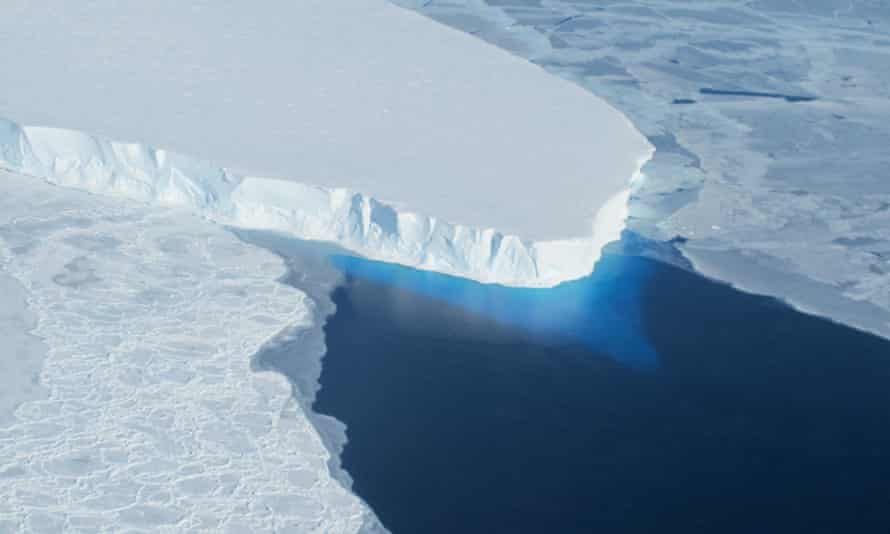Extract from The Guardian
World faces ‘abrupt jump’ in pace of ice loss around 2060 unless emissions reduced to meet Paris agreement goals, study warns.

An undated photo courtesy of Nasa showing the Thwaites glacier in western Antarctica. This tipping point for Antarctica could be triggered by a global temperature rise of 3C above the preindustrial era.
Last modified on Thu 6 May 2021 02.26 AEST
The current pace of global heating risks unleashing “rapid and unstoppable” sea level rise from the melting of Antarctica’s vast ice sheet, a new research paper has warned.
Unless planet-heating emissions are swiftly reduced to meet the goals of the Paris climate agreement, the world faces a situation where there is an “abrupt jump” in the pace of Antarctic ice loss around 2060, the study states, fueling sea level rise and placing coastal cities in greater peril.
“If the world warms up at a rate dictated by current policies we will see the Antarctic system start to get away from us around 2060,” said Robert DeConto, an expert in polar climate change at the University of Massachusetts and lead author of the study. “Once you put enough heat into the climate system, you are going to lose those ice shelves, and once that is set in motion you can’t reverse it.”
This tipping point for Antarctica could be triggered by a global temperature rise of 3C (5.4F) above the preindustrial era, which many researchers say is feasible by 2100 under governments’ current policies. The new research, published in Nature, finds that ice loss from Antarctica would be “irreversible on multi-century timescales” should this happen, helping raise the world’s oceans by 17cm to 21cm (6.69in to 8.27in) by the end of the century.
If the world was able to meet commitments made in the Paris deal, however, the research found Antarctica would contribute 6cm to 11cm of sea level rise by the end of the century, on a par with the current rate of ice loss. Under the Paris agreement, governments have vowed to limit dangerous global heating below 2C hotter than preindustrial times, with efforts to keep the increase to 1.5C.
“It’s really the next few decades that will determine the sea level rise from Antarctica,” De Conto said. “These ice shelves won’t be able to just grow back.”
Scientists have increasingly issued warnings over the fate of the huge amount of ice stored in Antarctica which, if it all melted, would raise global sea levels by 57 metres, completely submerging the world’s coasts.
While this won’t happen in any sort of foreseeable timescale, even a small increase in ice loss would be felt in global sea levels. Of particular concern is the western section of the Antarctic ice sheet, with scientists currently exploring the rate of decline experienced by the Thwaites glacier, also known as the doomsday glacier. In a worst-case scenario, the loss of the glacier, which is about the size of Britain and 1km deep, would raise sea levels by 65cm.
Antarctica is being winnowed away by a warming atmosphere as well as the heating oceans, with warming seawater entering crevasses and gnawing away at “pinning points” that hold enormous bodies of ice to submerged bedrock. A rapid acceleration of melting could cause a cascading effect where huge amounts of ice and water flow uninterrupted into the Southern Ocean.
Once in motion, the impacts from such dramatic ice loss would unfurl over centuries. “In the century after 2100 it’s potentially catastrophic,” said DeConto. “If we did nothing at all to reduce emissions we could get 5 metres of sea level rise just from Antarctica by 2200, at which point you’d have to remap the world from space. It would be unimaginable.”
DeConto’s paper uses a mode that incorporates temperature increase and ice loss, as well as the dynamic processes at play in Antarctica that present challenges in predicting exactly what will happen as the world continues to heat up.
Another study published in Nature on Wednesday, by scientists at King’s College in London, finds the sea level will rise by 0.5cm every year by 2100 if the global temperature rise hits 3C. DeConto said the other paper is an “impressive piece of work” but differed from his paper, which factored in compounding impacts from the loss of ice shelves.
“Neither of these papers are the last word, this is ongoing work,” he said. “Basically we are going to have to cope with continued sea level rise. The real question is whether it will be at a manageable or unmanageable rate for us.”
Orrin
Pilkey, a sea level rise expert at Duke University who was not involved
in the research, said the paper is an “important attempt to relate the
Paris agreement to reality”.
He added: “I would consider this a
thoughtful and even frightening but credible contribution which should
provide a very strong basis to get on with implementation of the Paris
agreement.”
Andrea Dutton, an expert in sea level rise at University of Wisconsin–Madison, who was a co-author, said the paper “addresses an important and pressing question” of what the Paris climate targets will mean for future sea level rise.
“We are already struggling with the amount of sea level rise that has occurred over the past century,” said Dutton, who added that a major acceleration in Antarctic melting will “bring about coastal retreat and migration on a scale that we have never before witnessed”.
“We will not be able to just adapt because it is impossible to just engineer our way out of this,” she said. “The conclusion is a stark reminder of the urgency in making deep and sustained cuts in our greenhouse gas emissions.”
No comments:
Post a Comment